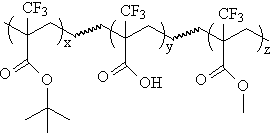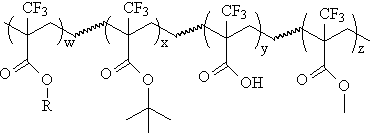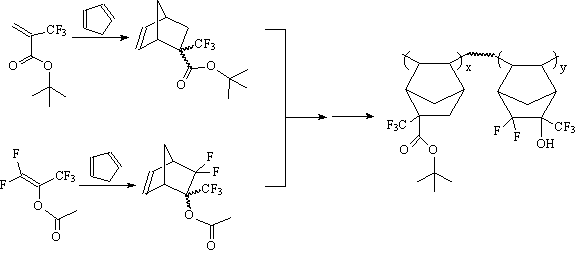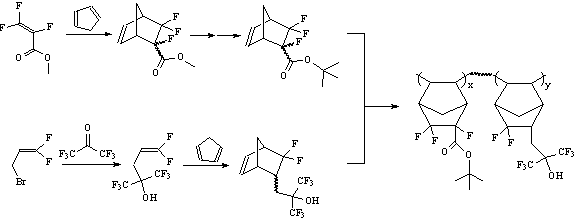|
|
||
|
Development of 157 Photoresist Materials The purpose of this document is to provide timely public access to the 157 nm resist development work being done in our laboratories under contract from International SEMATECH. It is our goal and SEMATECH's goal to disseminate this information as rapidly and widely as possible in hope that doing so will accelerate the availability of 157 nm resist materials to the members of International SEMATECH. Fluorocarbon Backbone Module Our research group has placed a large amount of focus on cabon-based polymers for the backbone module of 157 nm photoresists. The use of these materials holds an advantage over silicon-based materials since it allows the extension of existing DUV or 193 nm photoresist polymers to 157 nm designs. Unfortunately, studies have shown that in existing photoresist materials absorb strongly at this wavelength (1), and that only through strategic placement of electron-withdrawing substituents can this absorbance be attenuated (see etch resistance section). Acrylates Acrylate polymers have been used extensively in 193 nm photoresist designs due to their facile functionalization and favorable polymerization characteristics(2). Unfortunately, the p-system in these polymers contributes a large amount of absorbance at 157 nm and effectively precludes their use at this wavelength. However, our research group has recently shown the absorbance of these materials can also be significantly decreased through the addition of electron-withdrawing substituents(3). For example, poly(methyl trifluoromethacrylate) was prepared from the commercially available acid(4), and polymerized according to literature procedures(5).
The absorbance spectrum of the final homopolymer is displayed below, showing that this material has an absorbance of ~3 / mm, less than half that of PMMA.
To confirm that the favorable imaging characteristics of acrylates has not been adversely affected, poly(tert-butyl trifluoromethacrylate) was prepared(6) and is undergoing preliminary imaging experiments.
Although the results from these experiments will give some indication of the potential performance available from this class of materials, a candidate for an actual photoresist polymer will most likely have to follow a model similar to that described for acrylates as 193 nm photoresists(2). To that end, we are in the process of preparing the acrylate ter- and tetrapolymers shown below to determine their imaging potential.
R=Fluorinated alicyclic unit for etch-resistance (see etch resistance section) Vinyl addition polymerization of alicyclics Our project of systematically replacing hydrogen with fluorine on alicyclic units to their decrease absorbance is an ongoing project (see etch resistance section).However, preliminary results are encouraging enough to indicate that alicyclic units might be useful in 157 nm photoresist designs. Promising alicyclic monomer units can be readily prepared from the fluorinated acrylates described in the previous section. Additional alicyclic monomers can be envisioned from other fluorinated acrylates and olefins such as the pentafluoroisopropenyl acetate(7) or 3-bromo-1,1-difluoro-propene(8) shown below. This provides a pool of potential monomers to produce promising photoresist polymer candidates via transition metal-catalyzed vinyl addition polymerization. Several monomers have been prepared and experiments to produce polymers are underway.
Free radical polymerization of alicyclics A second method of polymer formation with alicyclic monomers is through copolyermization with electron-poor comonomers such as malice anhydride. This was the basis of our research group’s 193 nm photoresist platform(9). Unfortaunely, such materials demonstrate high absorbance at 157 nm due to both the alicyclic and carbonyl subunits in the repeat unit. However, we have shown that the absorbance of the alicyclic unit can be attenuated by the addition of fluorine. We hope to apply the same method to decrease the absorbance of the maleic anhydride comonomer to allow this polymer class to be used as 157 nm photoresists. The preparation of difluoromaleic anhydride has been previously reported(10), and we are currently working to form the promising copolymer shown below.
1) Bloomstein, T. M., Horn, M. W., Rothschild, M., Kunz, R. R., Palmacci, S. T., Goodman, R. B., “Lithography with 157 nm Lasers”, J. Vac. Sci. Technol. B, 1997, 13(6), 2112. 2) Allen, R. D., Wan, I. Y., Wallraff, G. M., DiPietro, R. A., Hofer, D. C., Kunz, R. R. “Microelectronics Technology; Polymers for Advanced Imaging and Packaging” American Chemical Soceity, Washington D.C., 1995, Ch. 17. 3)Conley, Will Presentation, International Symposium on 157nm Lithography, Dana Point, California, 2000. 4) C. Botteghi, C. Lando, U. Matteoli, S. Paganelli, G. Menchi, J. Fluorine Chem. 1997, 83(1), 67 5)H Ito, ACS Symposium Series 696, “Application of anionic polymerization research” 1996, 218. 6)A. L. McCloskey, G. S. Fonken, R. W. Klüber, W. S. Johnson, Org. Synth. Coll. Vol. IV, 1963, 261 7)Y. V. Zeifman, S. A. Postovoi, L. S. German, Russ. Chem. Bl. 1994, 43(1), 170. 8)H. Muramatsu, P. Tarrant, J. Org. Chem. 1964, 29, 1796. 9)K. Patterson, U. Okoroanyanwu, T. Shimokawa, S. Cho, J.D. Byers, C.G. Willson, "Improving the Performance of 193 nm Photoresists Based on Alicyclic Polymers", Proc. SPIE, Adv. in Resist Technology and Processing, 1998, 3333, 425. 10)Krespan, U. S. Patent #5,112,993, 1992. | |
|
|
||









